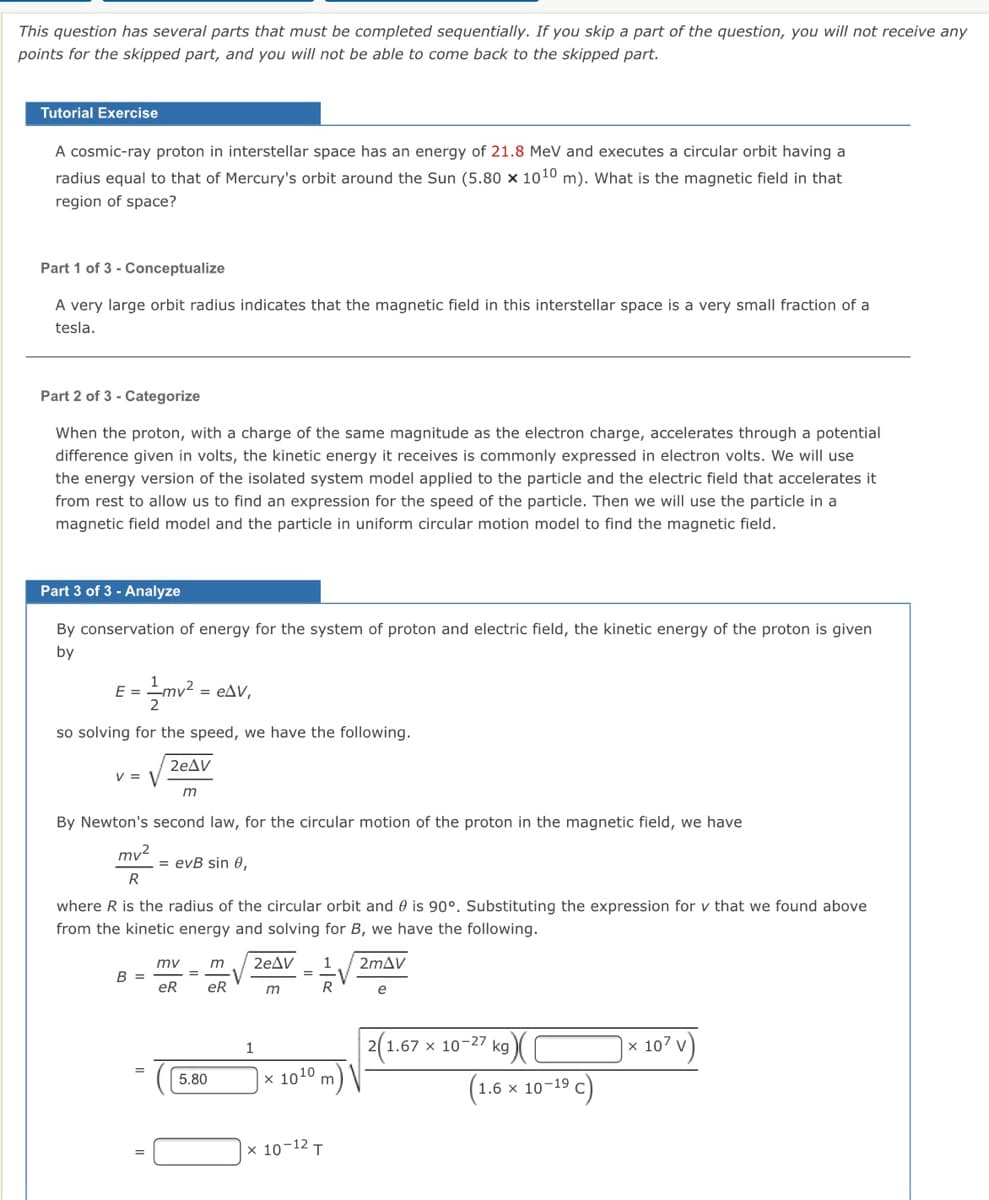A cosmic-ray proton in interstellar space has an energy of 21.8 MeV and executes a circular orbit having a radius equal to that of Mercury's orbit around the Sun (5.80 x 1010 m). What is the magnetic field in that region of space?
A cosmic-ray proton in interstellar space has an energy of 21.8 MeV and executes a circular orbit having a radius equal to that of Mercury's orbit around the Sun (5.80 x 1010 m). What is the magnetic field in that region of space?
Physics for Scientists and Engineers, Technology Update (No access codes included)
9th Edition
ISBN:9781305116399
Author:Raymond A. Serway, John W. Jewett
Publisher:Raymond A. Serway, John W. Jewett
Chapter25: Electric Potential
Section: Chapter Questions
Problem 25.56AP: Review. From a large distance away, a particle of mass m1, and positive charge q1 is fired at speed ...
Related questions
Question

Transcribed Image Text:This question has several parts that must be completed sequentially. If you skip a part of the question, you will not receive any
points for the skipped part, and you will not be able to come back to the skipped part.
Tutorial Exercise
A cosmic-ray proton in interstellar space has an energy of 21.8 MeV and executes a circular orbit having a
radius equal to that of Mercury's orbit around the Sun (5.80 × 1010 m). What is the magnetic field in that
region of space?
Part 1 of 3 - Conceptualize
A very large orbit radius indicates that the magnetic field in this interstellar space is a very small fraction of a
tesla.
Part 2 of 3 - Categorize
When the proton, with a charge of the same magnitude as the electron charge, accelerates through a potential
difference given in volts, the kinetic energy it receives is commonly expressed in electron volts. We will use
the energy version of the isolated system model applied to the particle and the electric field that accelerates it
from rest to allow us to find an expression for the speed of the particle. Then we will use the particle in a
magnetic field model and the particle in uniform circular motion model to find the magnetic field.
Part 3 of 3 - Analyze
By conservation of energy for the system of proton and electric field, the kinetic energy of the proton is given
by
E =
mv? = eAV,
so solving for the speed, we have the following.
2eAV
V = V
By Newton's second law, for the circular motion of the proton in the magnetic field, we have
mv2
= evB sin 0,
R
where R is the radius of the circular orbit and 0 is 90°. Substituting the expression for v that we found above
from the kinetic energy and solving for B, we have the following.
mv
m
2eAV
1
2mAV
В 3
eR
%3D
eR
m
e
2(1.67 x 10-27 kg
x 107 v
5.80
x 1010 m) \|
(1.6 x 10-19 c)
x 10-12 T
Expert Solution
This question has been solved!
Explore an expertly crafted, step-by-step solution for a thorough understanding of key concepts.
This is a popular solution!
Trending now
This is a popular solution!
Step by step
Solved in 3 steps with 3 images

Knowledge Booster
Learn more about
Need a deep-dive on the concept behind this application? Look no further. Learn more about this topic, physics and related others by exploring similar questions and additional content below.Recommended textbooks for you

Physics for Scientists and Engineers, Technology …
Physics
ISBN:
9781305116399
Author:
Raymond A. Serway, John W. Jewett
Publisher:
Cengage Learning

Principles of Physics: A Calculus-Based Text
Physics
ISBN:
9781133104261
Author:
Raymond A. Serway, John W. Jewett
Publisher:
Cengage Learning

Physics for Scientists and Engineers: Foundations…
Physics
ISBN:
9781133939146
Author:
Katz, Debora M.
Publisher:
Cengage Learning

Physics for Scientists and Engineers, Technology …
Physics
ISBN:
9781305116399
Author:
Raymond A. Serway, John W. Jewett
Publisher:
Cengage Learning

Principles of Physics: A Calculus-Based Text
Physics
ISBN:
9781133104261
Author:
Raymond A. Serway, John W. Jewett
Publisher:
Cengage Learning

Physics for Scientists and Engineers: Foundations…
Physics
ISBN:
9781133939146
Author:
Katz, Debora M.
Publisher:
Cengage Learning

College Physics
Physics
ISBN:
9781938168000
Author:
Paul Peter Urone, Roger Hinrichs
Publisher:
OpenStax College

Physics for Scientists and Engineers with Modern …
Physics
ISBN:
9781337553292
Author:
Raymond A. Serway, John W. Jewett
Publisher:
Cengage Learning

Physics for Scientists and Engineers
Physics
ISBN:
9781337553278
Author:
Raymond A. Serway, John W. Jewett
Publisher:
Cengage Learning